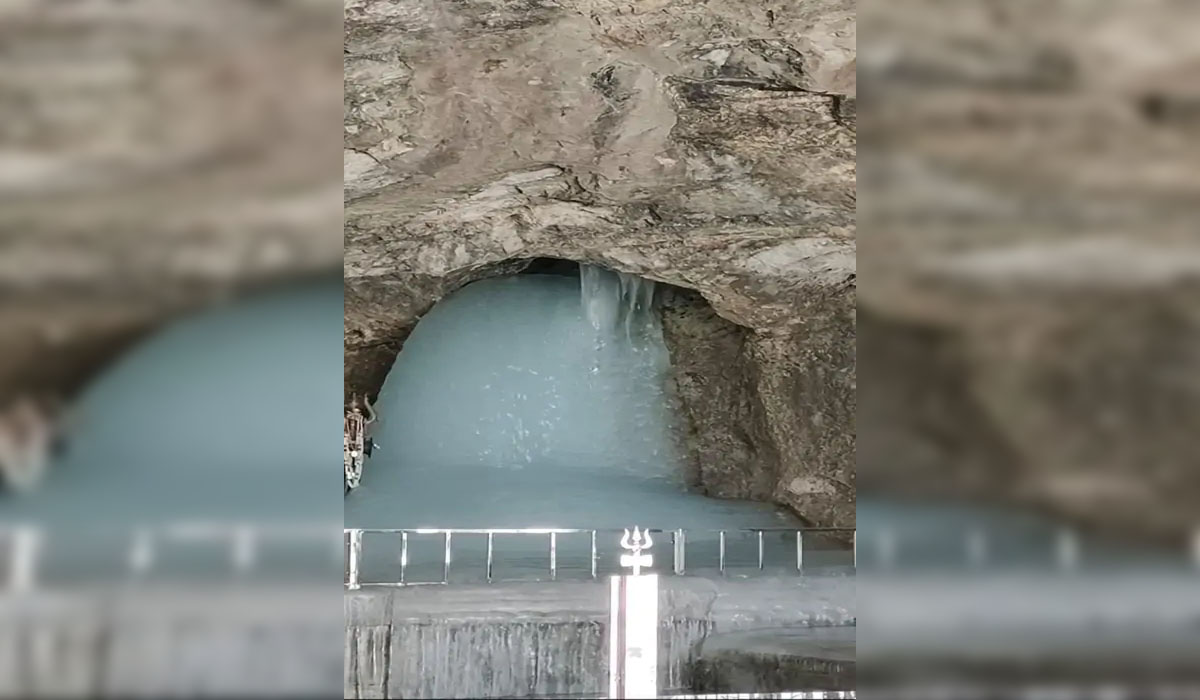
Srinagar, May 6: The first picture of Baba Barfani has emerged from the holy cave of Amarnath in Anantnag district of Kashmir. This time the Shivlinga made of ice is about 7 feet high.
Lakhs of people from all over the country come to Amarnath to see this Shivling. The yatra will start from July 3 and will last for about 38 days. It will be completed on August 9 on the day of Rakshabandhan.
Registration for the Yatra has started. The process of getting the necessary medical certificate is underway. Indians between the ages of 13 and 70 can undertake the Amarnath Yatra.
The Pahalgam terror attack on April 22 has not had any effect on the registrations for the Amarnath Yatra. So far, there have been 20% more registrations than last year.
Around 3.50 lakh devotees have done advance registration for Amarnath Yatra through offline and online modes from April 15.
The Shrine Board has also decided to improve the arrangements like e-KYC, RFID card, on-spot registration and others so that the pilgrimage can become more streamlined and secure.
The board says that this time more devotees may come than last time, therefore, arrangements for stay and registration are also being made at Jammu, Srinagar, Baltal, Pahalgam, Nunwan and Pantha Chowk.
ID verification of pony owners and local sevadars at the base camp
After the recent terror attack in Pahalgam, security arrangements have been tightened ahead of the Amarnath Yatra. Now “ponywallahs” and “local sevadars” are conducting registrations with ID checks at the base camp. Strict ID verification protocols are being followed to ensure the safety of pilgrims and smooth conduct of the yatra.
LG Manoj Sinha visited the base camp
Jammu and Kashmir Lieutenant Governor Manoj Sinha on Monday visited the Pantha Chowk transit camp in Srinagar to review the ongoing arrangements for pilgrims ahead of the Amarnath Yatra 2025. PNB Circle Chief Jammu Anil Sharma said that pregnant women, children below 13 years and those above 70 years of age will not be allowed to travel even if they have a medical certificate.
5 lakh passengers arrived in 2024
In 2024, this yatra was of 52 days. In 2023, the yatra lasted for 62 days, in 2022 for 43 days and in 2019 for 46 days. In 2020-21, the yatra was postponed due to the corona epidemic. In the 52-day Amarnath Yatra in 2024, more than 5 lakh devotees had darshan of Baba Barfani in the holy cave.
4.5 lakh pilgrims participated in 2023. In the year 2012, a record 6.35 pilgrims had darshan. In 2022, the figure decreased due to Kovid and 3 lakh pilgrims arrived for darshan.
How to reach: There are two routes for travel
1. Pahalgam Route: It takes 3 days to reach the cave through this route, but this route is easy. There is no steep climb in the journey. The first stop from Pahalgam is Chandanwadi. It is 16 km away from the base camp. The climb starts from here.
After climbing for three kms, the yatra reaches Pissu Top. From here, the yatra reaches Sheshnag by evening on foot. This journey is about 9 kms. The next day, the yatras go to Panchtarni from Sheshnag. This is about 14 kms from Sheshnag. The cave is only 6 kms from Panchtarni.
2. Baltal Route: If you are short on time, you can go to Baba Amarnath Darshan via Baltal route. It involves climbing only 14 kms, but it is a very steep climb, so elderly people face difficulty on this route. This route has narrow paths and dangerous turns.
What to keep in mind
During the journey, keep medical certificate, 4 passport size photos, Aadhar card, RFID card, travel application form with you. For physical fitness, practice walking 4 to 5 kilometers every day. Do breathing yoga like pranayama and exercise. Keep woolen clothes, raincoat, trekking stick, water bottle and a bag of essential medicines with you during the journey.
Himani Shivling is formed in Amarnath
Amarnath Shivling is a wonderful natural ice-made structure, which is called Himani Shivling. Amarnath cave is located at an altitude of about 3,888 meters above sea level. This cave is north-facing, due to which very little direct sunlight reaches it. Due to this, the temperature inside the cave remains below 0 ° C, due to which the ice freezes easily.
Water drips continuously from the roof of the cave, which comes from melting of nearby glaciers or snow. When the water slowly falls down and freezes, it moves upwards in the shape of a pillar or linga. This is scientifically called stalagmite.
